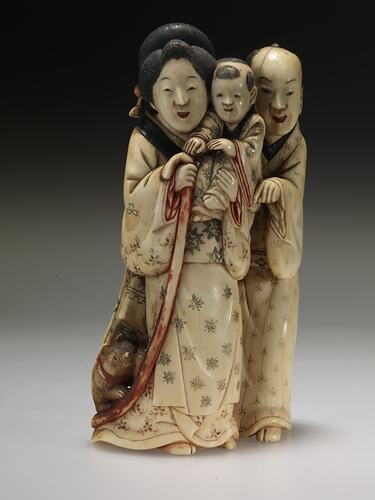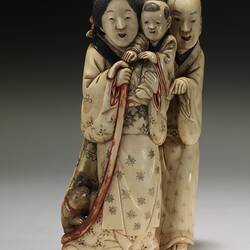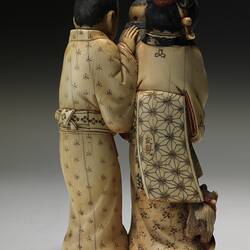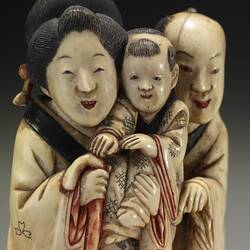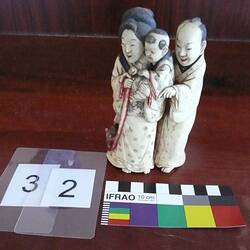Summary
Carved ivory family group (okimono) manufactured in Japan in the late Edo period (1825-1868) signed by the highly-skilled Tokyo ivory carver, Yamaguchi Chikuyosai Tomochika.
The appearance of the group, their clothing, and the father's hair style, suggest they may have belonged to a samurai class. The black collar of the mother's kimono is a stylistic feature common to women's kimono of the early nineteenth century. The group all wear tabi; white socks to be worm with the kimono.
An okimono is an small, carved Japanese decorative object created specifically for display, and typically depicts domestic scenes of farmers, fishermen, and children and occasionally, studies of birds, animals and flowers.
Similar to, but larger than netsuke - which served a practical function as a fastener or toggle - okimono were often presented in the tokonoma, an interior alcove or recesss in Japanese homes for the display of pictures or decorative art objects. During the Meiji period (1868-1912), many okimono were made for export to the west.
Physical Description
Group comprising mother, father, child and dog. The mother is holding the child in her left arm, between herself and the father. The dog is sitting on her skirt tail. Decorated with black etching and red highlights. At first glance, it appears that the ivory is very discoloured, however, upon closer inspection, and when viewed with the black and red stained ivory in mind, it is more likely that the ivory has been tea stained by the manufacturers to achieve different depths of colour in the overall design.
More Information
-
Collection Names
-
Collecting Areas
-
Acquisition Information
Cultural Gifts Donation from Dr Will Twycross, 23 Jan 2009
-
Acknowledgement
Donated through the Australian Government's Cultural Gifts Program
-
Artist
Yamaguchi Chikuyosai Tomochika, Tokyo, Japan, 1825-1873
early Meiji Period; Edo Period, 1603-1867; Meiji Period, 1868-1912 -
Place & Date Made
Japan, 1825-1873
early Meiji Period; Edo Period, 1603-1867; Meiji Period, 1868-1912 -
Place & Date Exhibited
Royal Exhibition Building (REB), Nicholson Street, Carlton, Greater Melbourne, Victoria, Australia, 1880-1881
-
Collector
Mr John Twycross, Elsternwick, Greater Melbourne, Victoria, Australia, 1881
-
Inscriptions
Kanji signature of Tomochika on back of female figure, on obi (the sash around her kimono)
-
Classification
Royal exhibition building, International exhibitions, Exhibition heritage
-
Category
-
Discipline
-
Type of item
-
Overall Dimensions
70 mm (Width), 30 mm (Depth), 125 mm (Height)
-
Maximum dimensions
70 mm (Width), 128 mm (Height), 175 mm (Circumference)
Measurement From Conservation. width of base 70mm, maximum depth approximately 35mm and maximum circumference 175mm
-
Keywords
Decorative Arts, Exhibitions: Melbourne International, 1880-1881, Ivory, Japanese Art, Japanese Culture, Royal Exhibition Building, Royal Exhibition Building: History of Events, 1879-1899
